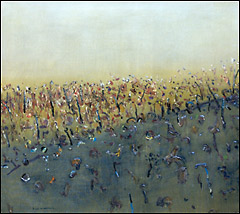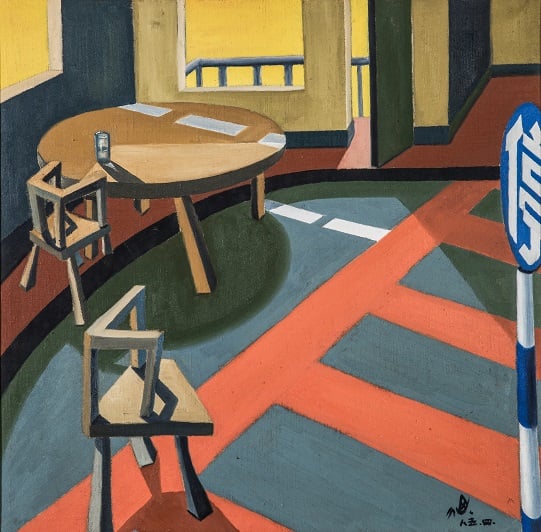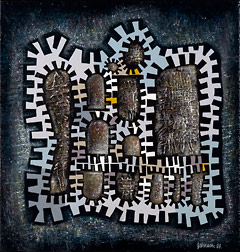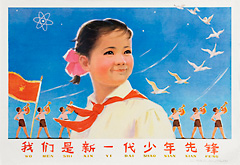La Trobe University art collections
La Trobe University Art Collection was established in 1965, before construction of the first buildings commenced at the site of the University’s Melbourne Campus at Bundoora. The University’s architect, Dr Roy Simpson AO, recognised the importance of an art collection in an educational environment. He incorporated the installation and display of artworks into his vision for La Trobe.
Through an active and considered acquisitions program, this significant collection now comprises approximately 2,500 postwar and contemporary artworks. It is representative of movements in Australian art of the past five decades and features many notable artists. The collection includes more than 20 public sculptures located in the Melbourne Campus Sculpture Park, the largest holdings of works by the Australian surrealist Bernard Boles and expatriate artist Allen David, and the Etta Hirsh Ceramics Collection, which consists of over 300 objects.

Image: Fred Williams, Scrub, Lysterfield, 1967, oil on canvas. La Trobe University Art Collection, LTU0594. Gift of the Williams family in memory of Jenny Wilkinson, 1987. © Estate of Fred Williams
Dr Geoff Raby AO acquired his collection over 30 years, from 1986, when he was first posted to Beijing as first secretary, head of the Economics Division at the Australian Embassy, to his term as Australian ambassador from 2007 to 2011, and beyond. Raby immersed himself in the burgeoning Beijing art scene and actively sought out the work being created in the capital and throughout China.
In 2019 Geoff Raby donated a collection of 174 works to La Trobe under the Cultural Gifts Program, an Australian Government initiative. It was the single largest cultural gift made to the University in its history.
The Geoff Raby Collection of Chinese Art surveys key aspects of contemporary art practice in China, dating back to the end of the Cultural Revolution in 1976. It comprises paintings, photography, works on paper, ceramics, sculpture and textiles by more than 70 artists and explores themes of social realism, political satire, humour, individual liberty, cultural exchange, traditionalism and nationalism. The collection is significant both as a contemporary art collection and as a resource for research and teaching in the fields of comparative cultural studies, social history and Asian studies.

Image: Ah Xian, ‘Stop’ from the series ‘Sense of security’, 1985, oil on canvas. La Trobe University, Geoff Raby Collection of Chinese Art, LTU2657. Donated by Dr Geoff Raby AO through the Australian Government’s Cultural Gifts Program, 2019. © Ah Xian. Photo: Jia De
Established by the University’s Anthropology Department in the 1970s, the Ethnographic Collection comprises approximately 800 objects including stone tools, carvings, Aboriginal barks, war shields, ceremonial dress, masks and headwear. Objects were acquired by donation over several decades and augmented by items collected by academics on field trips. Predominantly featuring content from Australia and Papua New Guinea, the collection also includes objects from the Solomon Islands and Africa.

Image: Tiwi, Bima husband, date unknown, natural earth pigments on wood. La Trobe University Ethnographic Collection, LTUE795. Donated by James and Irene Davidson
The collection was founded by Bendigo Teachers College (which become Bendigo CAE and then La Trobe University). Fred Courtis, then the head of art education at the Teachers College, initiated acquisitions of artworks in 1958. Intended as a valuable teaching resource, the collection was developed to foster a national identity through the appreciation, understanding and enjoyment of the visual arts. Numbering 324 works, the FM Courtis Collection includes examples of prominent Australian artists from the impressionist period to today.

Image: George Johnson, Canto, 1965, oil and mixed media on board. La Trobe University, FM Courtis Collection, LTUC050. © Estate of George Johnson
The collection comprises a unique suite of 70 objects of antiquity with a focus on red-figured vases produced in the Greek colonies and native towns of South Italy and Sicily during the Classical period (5th and 4th centuries) that were the private holdings of lauded academic AD Trendall, bequeathed to the University in 1995. The collection is used by co-custodian the Trendall Research Centre which manages Trendall's collection of 40,000-plus photographs of red-figure vases and his extensive Classics library.
AD (Dale) Trendall (1909–1995) was a leading classicist, art historian and university administrator who, on his retirement from a long and distinguished academic career, became La Trobe University’s first resident fellow in 1969, remaining for 26 years.

Image: Unknown artist, Corinth, Greece, Corinthian aryballos, c. 620–590 BCE, terracotta. La Trobe University, Trendall Collection of Antiquities, LTU1995.01. Gifted to La Trobe University by AD Trendall under the Australian Government Taxation Incentives for the Arts Scheme 1995
The Stewart E Fraser Collection comprises almost 4,000 posters from China, the USSR and Vietnam produced between the 1960s and 1980s. Mostly political in nature, they promote views on issues such as civic duty, public health (including contraception) and community life and unity. There are also Australian posters relating to student life and politics, Aboriginal land rights and family planning.
Emeritus Professor Stewart Fraser (1929–2001) was founder of the University’s School of Education, and chair of education in the Centre for Comparative and International Studies in Education. He was born and spent much of his childhood in Tianjin, and was educated at the universities of Melbourne, Oxford, Stanford, Colorado and London.

Image: Ou Yang, We are the new generation of Young Pioneers, 1980, offset lithograph. La Trobe University, Stewart E Fraser Poster Collection, LTUSFP0035
The Larundel Collection is significant for its place in the mental health and art therapy history of Victorian health services. A collection of 1,450 works on paper by in-patients of the (then) Larundel Psychiatric Hospital, created at the Art Access Studio from the 1970s to the 1990s, on what is now the grounds of La Trobe University Melbourne Campus at Bundoora.
The premise of the Art Access Studio was not to use a patient’s creative output as a diagnostic tool (as other psychiatric art practices did), but to give the individuals the opportunity to create as an outlet for exploration and personal wellbeing. The collection was gifted to the University by the community organisation NEAMI in 2018.
Collections Significance Assessment
In 2016–17 we undertook the first significance assessment of the cultural collections of La Trobe University. The project encompassed the collections recognised as being under the ownership of the University and the custodianship of La Trobe Art Institute, and used recognised industry methodologies to assess these holdings. Three core results were achieved from the process:
- Identification and explanation of the significant history and worth of the collections
- Identification of existing areas of risk to the collections
- Recommendations to ensure the continuing integrity of the collections, including rectification of identified issues.
The report confirms that La Trobe University possesses collections of substantial merit. These are holdings worthy of any Australian institution.
Significance Assessment Report [PDF 7.8MB]
Significance Assessment summary [PDF 95KB]

Image: Leonard French, The legend of Sinbad the Sailor (detail), 1956, automotive paint and enamel on board. La Trobe University Art Collection. Donated under the Australian Government's Cultural Gifts Program by Mr Ion Nicolades, 1999
